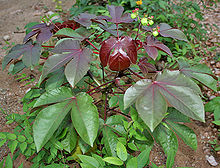Jatropha
In the 2000s, one species, Jatropha curcas, generated interest as an oil crop for biodiesel production and also medicinal importance when used as lamp oil; native Mexicans in the Veracruz area developed by selective breeding a Jatropha curcas variant lacking the toxic compounds, yielding a better income when used as source for biodiesel, because of its edible byproduct.Buddha belly plant (J. podagrica) was used to tan leather and produce a red dye in Mexico and the southwestern United States.[12] However, despite their abundance and use as oil and reclamation plants, none of the Jatropha species have been properly domesticated and, as a result, their productivity is variable, and the long-term impact of their large-scale use on soil quality and the environment is unknown.[13] 2009 research found that Jatropha biodiesel production requires significantly more water than other common biofuel crops, and that initial yield estimates were high.[14] Earlier, higher estimates from Worldwatch Institute had suggested that 1 acre of cultivation could yield 202 gallons (4.8 barrels) of biodiesel.






Jatropha integerrimaScientific classificationPlantaeTracheophytesAngiospermsEudicotsRosidsMalpighialesEuphorbiaceaeCrotonoideaeJatropheaeSpeciesflowering plantsspurgesucculent plantsshrubsdeciduousJatropha curcasAmericasOld WorldseparateflowersbiodieselSeri peopleSonoraKrameria grayiJ. integerrimacrimsonJ. podagricaleatherdiesel enginesbiogasfertilizerGoldman Sachsdroughtreclamationdomesticatedsoil qualitybiofuel cropsWorldwatch Institutecarbon sequestrationlectinphorbolJatropha gossypiifoliaanti-fungalHyderabad, IndiaJatropha bullockiiJatropha catharticaTeránBerland.Jatropha chamelensisJatropha costaricensisMüll.Arg.Jatropha dioicaJatropha ellipticaJatropha macranthaJatropha multifidaJatropha nudicaulisJatropha rivaeJatropha podagricaJatropha unicostataWest BengalAleurites moluccanusBaliospermum solanifoliumCnidoscolus aconitifoliusCnidoscolus angustidensCnidoscolus quercifoliusCnidoscolus stimulosusCnidoscolus texanusCnidoscolus urensHyaenanche globosaManihot esculenta subsp. esculentaRuiz & Pav.Chiov.Adans.United States Department of AgricultureBibcodeMuys BWayback MachineIntegrated Taxonomic Information SystemWikispeciesWikidataFloraBaseiNaturalistOpen Tree of LifePaleobiology DatabaseTropicos